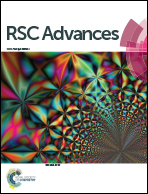The selective laser sintering of a polyamide 11/BaTiO3/graphene ternary piezoelectric nanocomposite†
Abstract
Piezoelectric materials featuring the capability of converting mechanical energy to electricity are very important for harvesting discrete mechanical energy to meet the rapidly increasing demand for cleaner energy. However, the intrinsic poor flexibility and processability make it difficult for current piezoelectric materials to fulfill their potential. This study reports a novel polyamide 11 (PA11)/BaTiO3 (BT)/graphene (Gr) ternary nanocomposite 3D printed part with significantly enhanced dielectric and piezoelectric properties due to its special discontinuous graphene network and microspores. The piezoelectric BT nanoparticles with excellent piezoelectric properties were uniformly dispersed into PA11 via a solid-state shear milling (S3M) technology. Moreover, via ultrasonic coating and selective laser sintering (SLS) technology, the discontinuous graphene network and microporous structures were both fabricated in the prepared 3D printed parts. The graphene interfaces acted as electrodes, and thus significantly increased the poling efficiency, while the porous structure further magnified the stress concentration. As a result, a piezoelectric coefficient (d33) of 3.8 pC N−1 and open-circuit voltage of 16.2 ± 0.4 V were obtained, exhibiting better comprehensive performances than those of most reported piezoelectric materials.



 Please wait while we load your content...
Please wait while we load your content...